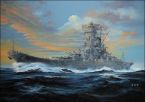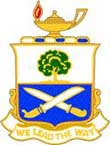castor troy
Posts: 14330
Joined: 8/23/2004
From: Austria
Status: offline

|
Yokosuka
MXY7 Ohka
Kamikaze Attack Plane
DESCRIPTION:
As the Japanese military became increasingly desperate to find ways of slowing the Allied advance, naval officer Ensign Mitsuo Ohta conceived a specialized suicide attack aircraft. This plane was to be inexpensive, easy to manufacture in large numbers, and equipped for high speed to avoid being shot down. Once the concept had been accepted, Yokosuka began developing the MXY7 Ohka (cherry blossom). The Ohka was a small, rocket-powered vehicle mounting a large warhead in the nose and intended to be carried to the target area by a Mitsubishi G4M2e bomber. After being released, the Ohka would engage its rocket motors to make a high-speed dash to the target ship.
Flight testing began in late 1944, but production of the Navy Suicide Attacker Ohka Model 11 began even before these tests were complete. By March 1945, 755 of the Model 11 had been built, but initial deployments proved rather unsuccessful. Although difficult to shoot down because of its high speed, the Ohka was a sitting duck when still attached to the large, slow mother plane. In addition, the design proved very difficult to maneuver making it nearly impossible to hit even a slow moving target.
In an attempt to improve the odds, a new version, the Model 22, began production. This model featured reduced wingspan and a smaller warhead allowing the Ohka to be carried by the much faster Yokosuka P1Y1 Ginga medium bomber. The Model 22 was also fitted with a Campini-type jet engine instead of rockets increasing the Ohka's range as well as reducing speed to allow better maneuverability. However, the jet engine was found to be vastly underpowered resulting in later versions powered by a turbojet, but none of these reached production before the end of the war.
Japan also studied other methods for launching the Ohka, including a land based version and one carried by submarines. Although some 850 Ohkas were built, including trainer versions equipped with landing skids, only 50 ever saw combat. These sank just three enemy ships.
Last modified 01 February 2005
HISTORY:
First Flight October 1944 [unpowered flight]
November 1944 [powered flight]
Service Entry
21 March 1945
CREW: 1 pilot
ESTIMATED COST:
unknown
AIRFOIL SECTIONS:
Wing Root unknown
Wing Tip
unknown
DIMENSIONS:
Length (Model 11) 19.90 ft (6.07 m)
(Model 22) 22.56 ft (6.88 m)
(Model 43B) 26.77 ft (8.17 m)
Wingspan (Model 11) 16.40 ft (5.00 m)
(Model 22) 13.52 ft (4.12 m)
(Model 43B) 29.53 ft (9.01 m)
Height (Model 11) 3.94 ft (1.20 m)
(Model 22) 3.94 ft (1.20 m)
(Model 43B) 3.77 ft (1.15 m)
Wing Area (Model 11) 64.59 ft2 (6.00 m2)
(Model 22) 43.06 ft2 (4.01 m2)
(Model 43B) 139.93 ft2 (13.02 m2)
Canard Area
not applicable
WEIGHTS:
Empty (Model 11) 970 lb (440 kg)
(Model 22) 1,200 lb (545 kg)
(Model 43B) 2,535 lb (1,150 kg)
Typical Load unknown
Max Takeoff (Model 11) 4,720 lb (2,140 kg)
(Model 22) 3,200 lb (1,450 kg)
(Model 43B) 5,005 lb (2,270 kg)
Fuel Capacity internal: unknown
external: unknown
Max Payload
(Model 11) 2,645 lb (1,200 kg)
(Model 22) 1,325 lb (600 kg)
(Model 43B) 1,745 lb (790 kg)
PROPULSION:
Powerplant (Model 11) three Type 4 Mk 1 solid-propellant rocket motors
(Model 22) one TSU-11 Campini-type jet
(Model 43B) one Ne-20 turbojet
Thrust (Model 11) 1,765 lb (7.85 kN)
(Model 22) 550 lb (2.45 kN)
(Model 43B) 1,045 lb (4.65 kN)
PERFORMANCE:
Max Level Speed at sea level:
(Model 11) 535 mph (860 km/h)
(Model 22) 300 mph (480 km/h)
(Model 43B) 345 mph (555 km/h)
dive speed: 620 mph (1,000 km/h)
Initial Climb Rate unknown
Service Ceiling unknown
Range (Model 11) 50 nm (90 km)
(Model 22) 70 nm (130 km)
(Model 43B) 150 nm (275 km)
g-Limits unknown
ARMAMENT:
Gun none
Stations none
Air-to-Air Missile none
Air-to-Surface Missile none
Bomb (Model 11) one 1,200-kg warhead
(Model 22) one 600-kg warhead
(Model 43B) one 790-kg warhead
Other none
KNOWN VARIANTS:
Model 11 First production model powered by a three-chamber rocket motor and carried to within target range by a G4M2e bomber; 755 built
K-1 Unpowered trainer version based on the Model 11 but with the warhead removed and replaced by water ballast that was ejected to reduce landing speeds; 45 built
Model 22 Smaller, lighter version with a reduced wingspan and a smaller warhead so the aircraft could be carried by the smaller but faster P1Y bomber, the rocket motor was replaced by a Campini-type jet engine but this was found to be underpowered; 50 built
Model 33 Model to be powered by one Ne-20 turbojet and carried aloft by a Nakajima G8N Renzan bomber; cancelled
Model 43 K-1 Kai Two-seat trainer powered by a single Type 4 Mk I Model 20 rocket motor and fitted with flaps and landing skis; 2 built
Model 43A Enlarged model to be powered by one Ne-20 turbojet and fitted with folding wings so as to be carried aboard and launched from submarines; not built
Model 43B Model 43A variant to be launched by catapult from land and fitted with wing tips that could be jettisoned to increase speed; not built
Model 53 Turbojet-powered variant to be towed into the air by any aircraft fitted with a towline; not built
The war has to last very long if you want to build those numbers too! Though as tests have shown, no matter if you would build 1000 a month, Ohkas don´t work anyway!  If not a patch has anything changed then they still don´t work. Can´t remember who did the testing but what I CAN remember is that they NEVER EVER hit something... not unrealistic, though then all the work coding the thing was not worth it... If not a patch has anything changed then they still don´t work. Can´t remember who did the testing but what I CAN remember is that they NEVER EVER hit something... not unrealistic, though then all the work coding the thing was not worth it...  Real life hit rate 3 out of 50.... Real life hit rate 3 out of 50....
not to forget the source of this article: www.aerospaceweb.org/aircraft/attack/ohka/
< Message edited by castor troy -- 6/18/2007 10:58:12 AM >
_____________________________
|
 Printable Version
Printable Version









 ...if they had experience, they wouldn't be around to do it again...
...if they had experience, they wouldn't be around to do it again...

 )
)

 If not a patch has anything changed then they still don´t work. Can´t remember who did the testing but what I CAN remember is that they NEVER EVER hit something... not unrealistic, though then all the work coding the thing was not worth it...
If not a patch has anything changed then they still don´t work. Can´t remember who did the testing but what I CAN remember is that they NEVER EVER hit something... not unrealistic, though then all the work coding the thing was not worth it... 




 must get special privileges granted in the game code
must get special privileges granted in the game code 






 New Messages
New Messages No New Messages
No New Messages Hot Topic w/ New Messages
Hot Topic w/ New Messages Hot Topic w/o New Messages
Hot Topic w/o New Messages Locked w/ New Messages
Locked w/ New Messages Locked w/o New Messages
Locked w/o New Messages Post New Thread
Post New Thread